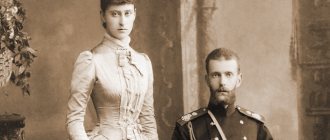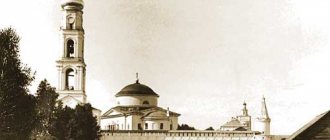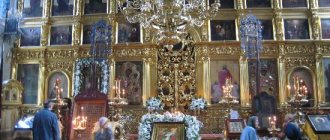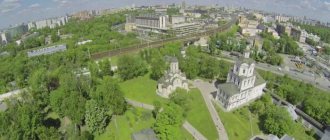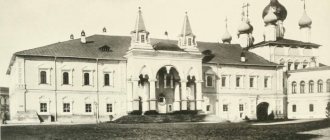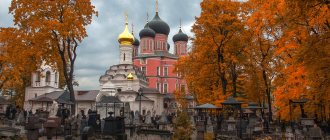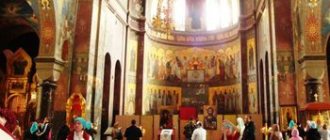Among monasteries, the Marfo-Mariinskaya Monastery in Russia occupies a special place. Both because it is located in the heart of the capital, and because the reasons for its founding were brutal murder and the majesty of forgiveness.
History of creation
The beginning of the twentieth century became for the Russian Empire not only a time of revolutionary unrest, but also years of spiritual upliftment. While some threw themselves into fashionable Marxist circles, others sought solace in God.
Construction and foundation
The death at the hands of the Socialist-Revolutionary bomber Kalyaev, Prince Sergei Romanov, forced his wife to take the path of serving the sick in body and spirit. For this purpose, Grand Duchess Elizabeth bought several houses on Ordynka, which were adapted to the needs of a charitable institution.
origin of name
The monastery was supposed to resemble the house of Lazarus, resurrected by Jesus, a friend in whose home the Savior often visited. Lazarus’s sisters, Mary and Martha, personified for Elizabeth spirituality in its purely feminine understanding and service to God through selfless help to those suffering from illnesses.
Historical fate
The establishment quickly gained fame. Thanks to its favorable location and special status, it attracted the attention of those who needed help and patrons who wanted to support a good initiative.
The most eminent doctors of the capital were engaged in receiving patients and training nurses, and the hospital was considered the best in Moscow. Respect for the institution was so high that it continued to function even after the Bolsheviks seized power. However, in 1918, the abbess and nun Varvara were arrested and deported.
And after that, the Bolshevik “kulturtragers” were looking for a plausible excuse to close the establishment. They tried to resolve the issue without heating the churches, and organized persecution of the sisters in the media, accusing them of embezzlement of funds and, of course, anti-Soviet agitation.
The most prominent cultural figures came out to defend the unique monument of church architecture. It was only thanks to their courage that the monastery was preserved with minimal losses.
Under Soviet rule, a cinema, a clinic, workshops and laboratories were located there. At a time when the monastery was a House of Health Education, a statue of the Kremlin highlander, Stalin, was installed in the altar of its temple.
Recovery and restoration
Everything superfluous and superfluous, which the godless government tried to implant in the monastery for eight decades, turned out to be fragile, like a house built on sand. But the princess’s cause proved its durability and withstood the pressure of time and turmoil.
In the early 90s, Elizabeth's brainchild was revived.
Current situation
A number of social projects are being implemented aimed at sick children, orphans and lonely old people. Nuns and sisters of mercy live in the monastery and carry out separate ministries.
On October 11, 2021, the monastery celebrated the 100th anniversary of the martyrdom of St. Elizabeth Feodorovna.
There is an icon-painting workshop and three farmsteads in the Moscow, Tver and Oryol regions.
To the 100th anniversary of the Marfo-Mariinskaya Convent of Mercy. Part 1
| Church of the Intercession of the Virgin Mary |
The year 2009 was marked by an anniversary significant for all of Orthodox Russia - the 100th anniversary of the Martha and Mary Convent of Mercy.
The monastery is located in the very center of Moscow on Bolshaya Ordynka Street. Today it is difficult to find a person who has never heard of this amazing place, which has become one of the main Moscow attractions. The white stone walls of the monastery, surrounded by miraculously preserved ancient merchant mansions, add an inexplicable charm to this corner of Zamoskvorechye. Everything here breathes history, everything bears the imprint of the past. However, the main thing that every person who crosses the threshold of its Holy Gates feels is a gracious atmosphere of joyful peace and tranquility. This is what makes the Martha and Mary Convent a particularly attractive place for all those seeking consolation, help and support. Its history reflects the most important events of the past 20th century and the vicissitudes of the personal fate of the founder, Grand Duchess Elizabeth Feodorovna Romanova.
The life path of each person consists of certain stages common to all: childhood, adolescence, maturity, old age. This is a kind of canvas along which God’s Providence symbolically embroiders the fate of everyone with a bizarre pattern. The colors and weaves of threads in it are unique and inimitable, just as any human life is unique and inimitable. But there are destinies, the pattern of which is incomprehensibly intertwined with many others, absorbing all the colors of the surrounding world. Such people are endowed by God with a special gift of spiritual vision, lively participation and compassionate love for those who are close to them. This is exactly what the founder of the Marfo-Mariinsky monastery was like. Much has already been written and said about the life of the Grand Duchess. The main points of her biography are simple and at the same time paradoxical: a German princess, a native of a tiny duchy, who became the wife of the Russian Grand Duke, uncle of the sovereign of the largest country in the world; a brilliant secular lady who selflessly devoted herself to serving God and her neighbors with all the strength of her noble soul; a zealous Lutheran who confidently accepted Orthodoxy and at the end of her life was awarded the crown of martyrdom by the Lord.
On February 4, 1905, an event occurred that completely changed the life of Elizabeth Feodorovna. Her husband, Grand Duke Sergei Alexandrovich Romanov, died at the hands of the Socialist Revolutionary terrorist Ivan Kalyaev. After the death of her husband, the princess never took off her mourning and began to keep a strict fast and pray a lot. She conceived the idea of establishing a special women's community, whose members would devote their lives to active service to their neighbors. This decision was a logical continuation of the previous works of Elizaveta Fedorovna, who by that time headed the majority of charitable societies in Moscow.
In May 1907, with personal funds, the Grand Duchess purchased an estate in Zamoskvorechye that previously belonged to the merchants Solovyov, one of whom, Konstantin Makarovich Solovyov, was a famous bibliophile, a collector of books on the history and culture of Russia. The estate consisted of four separate buildings and a plot of land of one and a half hundred acres, a significant part of which was occupied by an old garden. Already in October she opened a military hospital here.
The path chosen by the Grand Duchess seemed very unusual to her contemporaries. In the lives of Russian saints there are examples when pious representatives of the upper class gave alms, clothed the naked, fed the hungry, and received strangers. In the Russian Middle Ages, many wives of princes left the world after the death of their husbands, retiring to monastic monasteries, such as the blessed Anna Kashinskaya or the Venerable Euphrosyne (in the world - Evdokia, the wife of the blessed Grand Duke Dimitri Donskoy). However, such profound changes that took place in the life of a still quite young woman, who had recently shone at social events, were not fully understood and accepted not only by the world, but also by those closest to her. Evidence of this is Elizabeth Feodorovna’s correspondence with Emperor Nicholas II, who initially opposed her desire to leave the court forever and devote herself to serving her neighbors.
| Interior of the main temple of the monastery |
In the 19th century, doing charity work was considered good form, especially among the aristocracy.
Many noble ladies, following this rule, visited the sick and needy, patronized educational institutions for the poor, orphanages and almshouses. In Russia, back in the 18th century, a special department for charity was organized, bearing the name of Empress Maria Feodorovna, the wife of Paul I. After her death, the department was successively headed by Empresses Alexandra Feodorovna, Maria Alexandrovna and Maria Feodorovna, the mother of Nicholas II. Obviously, the emperor assumed that the widow of Grand Duke Sergei Alexandrovich could well find herself in a similar field, while remaining in her usual comfortable environment. But Elizaveta Fedorovna’s nature was such that it did not allow her to make half-hearted decisions. Here is what she wrote to Emperor Nicholas II in April 1909: “Some do not believe that I myself, without any outside influence, decided to take this step; many people think that I have taken up an impossible cross and will either regret it and throw it off, or I will collapse under its weight. I accepted this not as a cross, but as a road full of light, which the Lord showed me after the death of Sergei and the desire for which appeared in my soul many, many years ago. I don’t know - when, it seems, from childhood I really wanted to help the suffering, especially those who suffer in soul... This desire grew in me, but in our situation at that time, when we had to host, make visits, arrange receptions, dinners, balls... I couldn’t devote my entire life to this...
You may not agree with such “big transitions in life,” but understand: for me this is not a “transition.” It grew gradually and has now taken shape, and many of those who have known me all my life and see me here were not at all surprised, but considered this change only a continuation of what had begun earlier, and she herself understood it this way...
Of course, I am unworthy of the immeasurable joy that the Lord gives me - to follow this path, but I will try, and He, Who is only love, will forgive my mistakes, because He sees how I want to serve Him... There have been so many things in my life in joy, in sorrow - there is so much boundless consolation that I long to give at least a particle of it to others...
I want you both and everyone to know what I have already spoken and written about many times: I am completely at peace, and perfect peace is perfect happiness... The Lord gave me a wonderful job on this earth. Whether I will fulfill it well or poorly, He alone knows, but I will try my best, and I put my hand in His and go, not fearing those crosses and attacks that this world has prepared for me... I want to work for God and in God for suffering humanity."
On February 10, 1909, in fulfillment of her intention, the Grand Duchess moved to live in the estate she had acquired along with several associates. This was the beginning of the creation of the Martha and Mary Convent of Mercy.
| Grand Duchess Elizaveta Feodorovna Romanova |
It was no coincidence that Elizabeth Feodorovna chose the holy sisters Martha and Mary, who are mentioned in the Gospel, as the heavenly patrons of the community.
Narrating how the Savior first came to the house of His disciple Lazarus, the Evangelist Luke testifies that one of Lazarus’s sisters, Martha, was knocked down, busy with the housework in order to adequately receive and feed her dear Guest. The other, Mary, on the contrary, abandoned all her affairs and, sitting at the feet of the Savior, listened to His words. Tired and somewhat annoyed, Martha asked Christ to send Mary to help her, to which He replied: “Martha! Marfa! You care and fuss about many things, but you only need one thing. Mary chose the good part, which will not be taken away from her” (Luke 10: 41-42). In these words of the Divine Teacher there is no condemnation or reproach towards the one who, by virtue of her understanding, preferred active, practical participation in the meeting of Christ. There is only an indication of the priority, “the only thing needed” - verbal service, the perception of the word of God, chosen by the wise Mary. This is an example for all subsequent generations of Christians who, following in the footsteps of the Savior’s disciples, should strive to intelligently combine the physical and spiritual, work and prayer, giving, however, preference to prayer. Undoubtedly, the Grand Duchess was driven by the desire to bring this New Testament ideal to life. But, perhaps, when naming the monastery, she also remembered another gospel story. It tells how, after the sudden death of Lazarus, it was the tears and sorrow of his sisters, whom the Savior sincerely loved, that preceded the miraculous resurrection of the deceased, who had already been in the coffin for four days. The Orthodox Church celebrates this event annually on the eve of Palm Sunday. Didn’t Elizaveta Fedorovna see the spiritually perishing Russian people in the image of the deceased Lazarus, placing hope that through the prayers of the sisters of the Martha and Mary community the Lord would resurrect them?
Confirmation of this can be seen in the fact that the most far-sighted and patriotically minded Russian people considered the opening of the Marfo-Mariinsky monastery to be the beginning of the moral cleansing of society. One of them was the philosopher Vasily Vasilyevich Rozanov, who dedicated an article to the monastery of mercy entitled “The Great Beginning in Moscow.” One of the philosopher’s friends subsequently thanked him for the fact that in his essay he drew everyone’s attention “toward the new wonderful idea of a person to whom God gave the talent to be inspiredly kind and the opportunity, due to his exceptional conditions, to express his idea actively.”
When creating the monastery, both Russian Orthodox and European experience were used. The charter was written by the Grand Duchess herself, guided by the blessing and advice of the elders of the Trinity-Sergius Lavra and the Vvedenskaya Optina Hermitage. According to her plan, nuns had to take vows of chastity, non-covetousness and obedience, however, unlike nuns, after a certain period of time they could leave the monastery and start a family. Based on the sketches of the artist Mikhail Vasilyevich Nesterov, a special vestment was created for them, close in cut to that of a monk.
Elizaveta Feodorovna, being a deeply religious person, began to build the monastery with firm hope in God. “Pray for my business, that the Lord may bless it, and that it will become stronger and benefit your country,” she wrote to Emperor Nicholas II in June 1909. “I won’t see it because I’m just getting started, but I’m happy about it.”
Metropolitan Vladimir (Epiphany) of Moscow provided great spiritual support and assistance to the princess in her great endeavor. By the providence of God, she found an invaluable assistant and adviser - Archpriest Mitrofan Serebryansky. Elizaveta Fedorovna learned about this priest back in 1906, after reading his book “The Diary of a Regimental Priest.” She wished to meet the author, calling him from Orel, where he served in the parish, to Moscow. Appreciating the gifted shepherd, she invited him to become the confessor of the young monastery. How highly the Grand Duchess valued Father Mitrofan is evident from her letter to the sovereign: “For our cause, Father Mitrofan is a blessing from God, since he laid the necessary foundation... He confesses me, cares for me in church, provides me with great help and sets an example with his pure, simple life - so modest and simple in his boundless love for God and the Orthodox Church. After talking with him for just a few minutes, you see: he is a modest, pure man of God, God’s servant in our Church.”
The monastery was gradually settling down. One of the buildings of the estate acquired by the Grand Duchess was given over to a hospital, a dormitory for sisters, a refectory, a kitchen, a pantry and other utility rooms. Next door were the chambers of Elizabeth Feodorovna herself. The third building at the opening of the monastery served as a military hospital, and then was converted into a pharmacy and an outpatient clinic, above which there were sister cells. The upper floor of the fourth building was occupied by the apartment of the confessor of the monastery, and below there was a library and Sunday school classrooms. A prosphora was attached to this building. In 1909, another plot of land adjacent to the garden of the monastery was acquired. Part of the house on the site was adapted to receive guests and pilgrims. In 1911, another three-story house was built, on two floors of which the sisters also lived, and on the first floor there was a bedroom for the girls of the orphanage that was later opened. All the buildings of the monastery, except the priest's house, were connected by internal passages, so that they could be walked around without going outside. A small one-story house was also built, which was used as a barracks for infectious patients. Later it began to be called the gardener's house. To his left stood a chapel where the dead were buried. The place in front of the chapel was named Golgotha in memory of the mountain where the Savior's Crucifixion took place. On the left side of the Holy Gate, according to the design of the architect Alexei Viktorovich Shchusev, a chapel was also built, where the nuns read the Indestructible Psalter.
On September 9, 1909, the great consecration of the first church of the monastery in the name of the holy women Martha and Mary took place, built in the house where the sisters lived and the hospital was located. The temple was consecrated by the vicar of the Moscow diocese, Bishop Trifon of Dmitrov (Turkestan). The church, which connected the hospital wards and the apartments of the abbess, was designed in such a way that the seriously ill could see the service from their beds. It was here that on April 9, 1910, Elizaveta Feodorovna and her first 18 companions were initiated into sisters of the cross.
“In the monastery church, a solemn all-night vigil was served by Bishop Tryphon, co-served by the rector of the church, Father Mitrofan Srebryansky, and other priests,” V.F. wrote in his memoirs. Dzhunkovsky. – Before the great doxology, the Grand Duchess and 18 sisters of the monastery made a solemn vow to devote themselves to serving their neighbors. And the next day, April 10, the Grand Duchess made a vow to rule the monastery she founded.
That day at 9:30 am Metropolitan Vladimir arrived. After the meeting, mass began.
The Grand Duchess and all the sisters were in light clothes. On the head there is an apostle - a white linen scarf that covers the head. On the chest there is a cypress eight-pointed cross with an image on the front side of the Savior Not Made by Hands and the Mother of God with an omophorion, outstretched hands, on the back there is an image of Saints Martha and Mary and the words of the Lord’s commandment about love for God and neighbors. On top of the apostle is a long veil that goes down from head to waist...
At the small entrance, with the Gospel, the protodeacon of the Cathedral of Christ the Savior led the Grand Duchess to the altar. After making three prostrations, the Grand Duchess approached Metropolitan Vladimir and, in response to his question, made a vow to govern the monastery of mercy in the spirit of the Orthodox Church until the end of her life.
The Metropolitan, having removed the cross and the sister’s veil from the Grand Duchess, read a special prayer and, placing the abbot’s cross and veil on her, proclaimed “Axios.” This ended the ceremony.
It was touching, touching, many had tears in their eyes... The excitement of something big and good that had happened was felt by everyone... From that day on, the Grand Duchess completely settled on Ordynka, leaving the Nikolaevsky Palace, and she was all concerned about her new brainchild - the abode of true mercy, in the full sense of the word.”
At the liturgy, after the dedication of the sisters of the cross, Bishop Tryphon, addressing them, said: “This clothing will hide you from the world, and the world will be hidden from you, but at the same time it will be a witness to your charitable activities, which will shine before the Lord for the glory His".
“For me, taking vows is something even more serious than getting married for a young girl. “I commit myself to Christ and His cause,” wrote Elizabeth Feodorovna to Emperor Nicholas II in March 1910.
The Grand Duchess told her like-minded women and followers:
“I am leaving the brilliant world where I occupied a brilliant position, but together with you all I am ascending into a greater world - the world of the poor and suffering.”
On November 20, 1910, Metropolitan Vladimir approved the first charter of the monastery, the purpose of which was “through the work of sisters... and in other possible ways to help in the spirit of pure Christianity the sick and poor and to provide help and comfort to those who are suffering and in grief and sorrow.”
When establishing the monastery of mercy, Elizaveta Fedorovna emphasized that the institution, which was new in form for the Russian Orthodox Church - the women's monastery of mercy - was based on the early Christian tradition. In ancient times, there was a special church rank of “deaconesses”, to which girls and widows were appointed. Their task was to assist priests in performing the sacrament of baptism over women, as well as to serve the needy and weak members of the Christian community with their labors. It was the sisters of the Martha and Mary Convent who saw themselves as the successors of this ancient ministry.
“We proceed from a strictly ecclesiastical foundation, Orthodox in all particulars, and we have the blessing of the Metropolitan, who, of course, knows our whole life... The Holy Synod finds that now is just the right moment to support the Church, to strengthen the shaken faith... They hope , that houses of sisters like ours will be founded. Because of this alone we must be confirmed as deaconesses,” the Grand Duchess wrote to her august brother-in-law in January 1912.
In view of the unusual and important undertaking of the Grand Duchess, the decision to allow the sisters of the monastery to be called deaconesses was considered by the Holy Synod, where it was supported by a majority of votes. Voted “for” were Metropolitan Vladimir of Moscow, Metropolitan Flavian of Kiev, Archbishop and Exarch of Georgia Innocent, Archbishop Sergius of Finland, Archbishop Anthony of Volyn, Archbishop Nazarius of Poltava, Bishop Eulogius of Kholm and Chief Prosecutor of the Synod V.K. Saber. Undoubtedly, Elizabeth Feodorovna's supporters in the matter of creating a monastery possessed special archpastoral wisdom and foresight. Evidence of this was the fact that subsequently almost each of them played a significant role in the modern history of the Russian Orthodox Church. Metropolitan Vladimir (Epiphany) of Moscow, who headed the Kyiv See in 1915, was shot by the Bolsheviks in 1918 and is now glorified as the New Martyrs and Confessors of Russia. Archbishop Anthony (Khrapovitsky) of Volyn, who emigrated after the revolution, stood at the origins of the creation of the Russian Orthodox Church Abroad. Bishop Evlogiy (Georgievsky) of Kholm, who also became an emigrant, ruled Russian Orthodox parishes in Western Europe. Archbishop Sergius (Stragorodsky) of Finland was elected His Holiness Patriarch of Moscow and All Rus' at the Local Council in 1943.
The life of the monastery was extremely simple, modest and unassuming.
“Our entire ministry is based on and lived by faith. Father instructs them (the sisters), three times a week we have wonderful lectures, to which guests also come. Then, during the morning rule, the priest reads from the Gospel and gives a short sermon, etc. I look after them, we talk...
We always drink tea together, and the priest and mother too, the conversation is about spiritual things... Then we will have a large refectory, as in monasteries, with the reading of lives, and I, as the abbess, will sometimes go out and see that everything is according to my instructions. There is a lot from the monastery in our life, I find it necessary,” the Grand Duchess wrote to Emperor Nicholas II on April 18, 1909.
In the garden of the monastery, according to Shchusev’s design, another temple was built - in honor of the Intercession of the Most Holy Theotokos - in memory of the soldiers who died in the Russian-Japanese War. The architect was recommended to the Grand Duchess by his longtime friend, the artist M.V. Nesterov. A detailed study of the design of the temple, which, according to the architect’s plan, was supposed to resemble the appearance of the medieval churches of Novgorod and Pskov, was carried out directly in the monastery with the active participation of its head. The foundation of the church building was laid on May 22, 1908. Elizaveta Feodorovna invited a gifted student of the Stroganov School, Nikifor Yakovlevich Tamonkin, to perform sculptural work and stone carving for the temple. It was he who completed all the sculptural decoration, reliefs on the walls, fountains in the garden, as well as the memorial plaque. Embedded in the north-eastern part of the altar apse, this white stone plaque has survived to this day, and everyone can read the text carved on it: “In the name of the Father and the Son and the Holy Spirit. Under the power of the most pious autocratic great sovereign Emperor Nicholas II Alexandrovich, in the personal presence of Her Imperial Highness Grand Duchess Elisabeth Feodorovna, Their Highnesses Princess Victoria of Battenberg, her daughter Princess Louise and Their Royal Highnesses Prince Andrew of Greece with his wife Royal Alice, concelebrated by His Grace Tryphon Bishop of Dmitrov , Archpriests Konstantin Zverev and Mitrofan Srebryansky, in the presence of the artist M.V. Nesterov and the builder of the temple, architect A.V. Shchusev, this temple was founded in the name of the Intercession of the Most Holy Theotokos in the year from the creation of the world 7416, from R.H. 1908, May 22, on the day of the Ascension of the Lord. Amen".
The head of the monastery, who had a keen sense of beauty and had great artistic taste, sought to decorate her beloved creation in accordance with the best traditions of Russian spiritual art. Academician of painting Mikhail Vasilyevich Nesterov, by that time already a recognized master, whose creative biography included participation in the creation, in collaboration with Viktor Mikhailovich Vasnetsov, of the frescoes of the Vladimir Cathedral in Kiev, was invited to paint the Intercession Church. The Grand Duchess's plan found a sincere and deep response in the soul of the great Russian painter.
| Nesterov's paintings |
“The community in the name of Mary and Martha and the temple in the name of the Intercession with it are being erected at the personal expense of the Grand Duchess.
And this is a matter of her soul. The whole undertaking, with provision for eternity, will not be cheap, and therefore the amount allocated for “art” is a relatively small one, and since my long-standing dream is to leave behind something solid in Moscow, I, despite the modesty of the allocation, accepted the project (to the sincere pleasure of the Grand Duchess). And having accepted it, naturally, I devoted myself entirely to this matter,” wrote M.V. Nesterov A.A. Turygin. Nesterov’s brushes included images of the iconostasis and the royal gates, as well as frescoes, among which a special place is occupied by the composition “The Path to Christ,” located above the western arch of the refectory. Essentially, this is an artistic reflection of the key gospel theme - sacrificial service as the path leading to God. “I proposed to write something akin to “Holy Rus'”: the sisters of the community of Martha and Mary in their white suits lead, point out to people Christ, who appears to these people in their sorrows and illnesses of soul and body, among the bright, spring nature. These people are not just “Russian people” either in image or in costume... (this is the idea of the community - evangelical, universal),” Nesterov later wrote, talking about the history of the creation of the painting. Based on his sketch, a mosaic icon of the Savior Not Made by Hands was created, placed in a niche above the entrance doors on the western facade of the church building.
In painting the Church of the Intercession, the great Nesterov was helped by a 19-year-old young man, a native of Palekh and a graduate of the local icon painting school, Pavel Korin. It was this talented master who, five years later, was entrusted by Elizaveta Feodorovna with painting the crypt of the Intercession Church.
On April 8, 1912, the consecration of the Intercession Church took place by Metropolitan Vladimir (Epiphany), Bishop Trifon (Turkestanov) and Serpukhov Bishop Anastasy (Gribanovsky). Particles of the relics of St. Alexis, Metropolitan of Moscow, Righteous Elizabeth and St. John Climacus were placed into the altar of this church, as before into the altar of the hospital hospital church.
According to Elizaveta Feodorovna’s plan, the refectory part of the Church of the Intercession was also intended for holding church and social events, that is, the monastery, in fact, was intended to become an educational center: lectures and spiritual conversations, meetings of the Palestine Society, Geographical Society, public readings of Orthodox literature and others were held here Events. The monastery of mercy provided support to many representatives of the artistic intelligentsia; Nikolai Golovanov, Sergei Yesenin, Nikolai Klyuev visited here...
Elizabeth Feodorovna's windows faced the altar side of the Intercession Cathedral. Usually she entered the temple through the service entrance and prayed, standing in the abbot's place at the right salt.
(The ending follows.)
Social activities of the monastery
The range of these types of activities is very wide. New demands of the time, the emergence of a new problem immediately resonates with the monastery staff.
Nursing
Nurses provide care for hospital patients. They constantly improve their qualifications through special medical courses.
Medical Center
Founded in 2010. Specializes in the treatment of children suffering from cerebral palsy. Treatment is free of charge and carried out by the best specialists in the field of cerebral palsy using an individual method.
During the existence of the center, hundreds of young patients have been rehabilitated.
Family Center
The main goal of this structure is to train adoptive parents. The center provides social and psychological support for Orthodox adoptive families.
Rehabilitation center
Provides comprehensive rehabilitation to patients suffering from cerebral palsy. The course lasts twenty days. Every year up to 400 children receive professional help here.
Children's mobile palliative service
The service has been operating since 2011. Monitors patients discharged from the hospital and provides comprehensive support to their families. Among other things, it provides nursing services.
Development Center
The only free kindergarten in Moscow for children with cerebral palsy. Valid for five years.
Holidays for families with disabled children
The project has been running since 2011. Within its framework, seaside holidays are organized for families with sick children. On a two-week vacation in Sevastopol, mothers and children are accompanied by volunteers.
Orphanage
In the orphanage, designed for fifteen children, girls from socially dangerous families and girls suffering from Down syndrome live and undergo rehabilitation.
In addition to compulsory school disciplines, pupils are taught singing, drawing, handicrafts, swimming and figure skating.
Volunteer service
The monastery welcomes everyone who wants to provide all possible assistance in a number of areas of the monastery’s social activities. Repair, transport, washing and other teams are formed from volunteers.
Working with applicants
Service specialists carefully understand the problems of those whose situation requires support. They collect documents for organizing treatment, study the opinions of experts and supervise the collection of necessary funds.
Resource Center
Operating from 2021. The center's activities are aimed at providing comprehensive social and psychological assistance to families raising disabled children.
The fate of the monastery in the 20th century
The Grand Duchess wanted the monastery to adopt not only the Russian experience of monasticism, but also to absorb the best traditions of foreign monasteries. In addition, she dreamed of having female clergy or deaconesses in our churches.
Cathedral of the Intercession of the Blessed Virgin Mary
Elizaveta Feodorovna took a lot of care about introducing the rank of deaconesses and even received the approval of the Holy Synod, which was conservative towards innovations. The Russian Orthodox Church was ready for female priests to begin serving in parishes. They could perform baptisms for other women, lead church services, and help the sick. However, the emperor opposed the innovation, and the decision was never made.
While in other monasteries the nuns led a reclusive life, in the new monastery the nuns helped in hospitals and did charity work. In order for them to do their work more professionally, the Grand Duchess attracted the best Moscow doctors to train the novices, and they taught the nuns the basics of nursing and competent care for the sick.
The doors of the monastery were always open. Spiritual readings were held here, and members of the Orthodox Palestine and Geographical Societies gathered. The new monastery was distinguished by the fact that the sisters were not chained to it forever. According to the charter, after a certain period of time they had the right to return to normal life.
View of the northern façade of the Cathedral of the Intercession of the Blessed Virgin Mary
The Grand Duchess lived within the walls of the monastery constantly. Her days were filled with prayer and working in hospitals. During the First World War, she, along with other nuns, raised money for the front and helped the wounded. For several years, the monastery managed to complete entire trains and send food, medicine and dressings to the front lines.
Two years after the start of the war, the number of disabled Russians increased, and the need for prosthetics arose. The founder of the monastery collected donations and began to build a factory for the production of prosthetics. It is interesting that this company still operates to this day and, just like a century ago, produces components for prosthetics.
With the advent of Soviet power, monastic life changed dramatically. In a short time, the Bolsheviks tried to get rid of all members of the royal family and other high-born Russians. The Grand Duchess was captured and sent to the Perm province. There, a 53-year-old woman was thrown alive into a spent mine near Alapaevsk. Seven more people died along with her.
Monument to Grand Duchess Elizabeth Feodorovna
The monastery was closed in 1926, when more than 100 nuns lived in it. Until 1928, a clinic operated on the territory of the monastery. Then the remaining sisters were evicted from the monastery. Some of them ended up in exile in the Turkestan steppes, while others ended up in the Tver province.
After the final liquidation of the monastery, the cathedral building was turned into a cinema, and then lectures on health education began to be held here. In the post-war period, restoration workshops were located in one temple, and an outpatient clinic was kept in the other. The monastery was returned to believers in the early 1990s, and the cathedral church began to belong to the church again in 2006.
Educational activities
The establishment has always been famous for the highly qualified specialists working there. The level of education taken back in tsarist times remains the calling card of the monastery today.
Foster parent training
Classes are conducted by child and family psychologists, social educators, lawyers, pediatricians and clergy. Those who graduate from the School are issued the appropriate documents.
Sisters internship
The main goal of the internships is to introduce sisters from Russian regions to the Moscow experience of social service. All internship programs are constantly improved taking into account the experience already gained and are designed for three to five days.
Training of tour guides
The nuances of the tour guide profession, the way and methods of presenting historical, church and cultural information are taught by teachers from Orthodox universities and experienced guides specially invited to the monastery.
After completing the courses, seminarians receive a standard certificate and, after an interview, can take part in the implementation of new pilgrimage projects of the Marfo-Mariinsky Convent.
Teaching church disciplines
Conducted since 2015. Includes free lectures for nuns of the monastery and staff of the monastery.
Lectures
Free lectures on the history of the Russian Orthodox Church are held at the monastery regularly. The topics discussed mainly concern persecution of the church, the confiscation of church valuables by the authorities and other adversities for which the history of the Russian Orthodox Church is so rich.
However, the lectures also touch on eternal topics. Thus, at one of them, held this year, listeners listened to the story of a RAS employee about icon painting as a way to continue reading Scripture without having the text itself at hand, but based on the visual perception of biblical images.
Announcement of new events is on the monastery website.
Current state of the monastery
For several years now, the convent has had stauropegial status. 30 nuns live here. The sisters serve a hospice and help terminally ill children, work in a canteen created for the poor, and work in military hospitals.
They teach at the gymnasium, run a children's home for orphans and a medical center that provides assistance to patients with cerebral palsy. Nuns who live in other departments of the monastery are required to undergo an internship in Moscow.
The Moscow monastery offers courses for pregnant women and classes at a school for adoptive parents. Day groups have been created here for children with developmental problems, and a lecture hall on church history has been opened. The volume of work that the monastery does cannot be accomplished by 30 nuns, so the monastery attracts volunteers for individual projects.
Chapel of Elizabeth Feodorovna
Association of Sisterhoods
The need to create a structure is due to the large number of sisterhoods in different parts of the world with different numbers of participants and different areas of activity. There is a need to streamline their activities. The association was created in 2010. The Chairman of the Association is Panteleimon, Bishop of Orekhovo-Zuevsky.
Goals and objectives
The structure was created to unite sisters of mercy and exchange useful experience in participating in social projects. It is expected that this will contribute to the creation of an international organization of sisterhoods, the formation of a Unified Database of the organization and the coordination of social programs.
Activity
According to the stated goals and objectives, since 2011, the Association has carried out a number of events, achieving positive experience in a variety of areas. Sisters and confessors from dioceses near and far abroad take part annually.
Architecture and decoration of the building
Appearance
Particular attention should be paid to the architecture of the Intercession Church, completely made in the Art Nouveau style. The temple is asymmetrical, each side is sharply different from all the others. The sculptural design was carried out by Sergei Konenkov, a friend of Sergei Yesenin.
Interior design
The frescoes decorating the Intercession Cathedral were made by the best artists of that time - Nesterov and his student Korin. By the way, Pavel’s wife Korin became one of the pupils of the monastery, whom he, while still very young, captured in his painting. Korin painted the underground temple of the Intercession Cathedral with frescoes.
Nesterov had to rewrite the fresco “The Path to Christ” again.
It was a matter of poor quality primer. With the words “I made the demon angry, I made him so angry,” the icon painter repeated the work, but on a copper board. In addition, Nesterov managed to achieve airiness and glow, thanks to the precise distribution of paintings, ligatures and other fragments of decoration - none of them dominates the others, but fits harmoniously into the overall picture.
Monastery buildings
The monastery territory is small, but very wisely organized. Here, without disturbing others, you can freely breathe fresh air in the gazebo or take a walk with your child on the playground. The small paths laid around the monastery are reminiscent of English gardens, and the monastery is decorated with an expressive monument to Elizabeth Feodorovna.
The cathedral church was designed by the famous architect Alexei Shchusev and erected in 1912. The architect managed to achieve harmony between the Art Nouveau style, popular at that time, and the traditions of ancient Russian church architecture. The interior paintings in the temple were made by talented Russian painters Mikhail Vasilyevich Nesterov and Pavel Dmitrievich Korin.
The Intercession Church is small in size and can accommodate up to 1000 people. There are 12 bells hanging on its belfry, and their sound is very similar to the famous bells of Rostov the Great.
Nearby is a temple dedicated to Mary and Martha. It was erected in 1909 and for a long time served as a house church at the hospital. The Marfo-Mariinsky Church was designed so that bedridden patients could observe the progress of church services.
Wall fountain
In addition to two churches, the monastery has a small chapel dedicated to the founder of the monastery. There is also a one-story gardener's house and a gatehouse building, where a chapel in honor of Seraphim of Sarov is located.
Temple shrines
All of them are in one way or another connected with those who worked in the monastery from the first days of its foundation.
The sad fact is that those who gave mercy to others also died a martyr's death.
Among the shrines of the Monastery:
- a particle of the relics of Elizabeth Feodorovna;
- a particle of the relics of the nun Varvara;
- particles of the relics of the confessor Sergius and the cleric Gabriel.
Architectural ensemble
Includes the house church of Saints Martha and Mary and the two-pillar Intercession Cathedral. Under the temple there is a church-tomb. The sacristy is adjacent to the cathedral on the south side, and the vestibule on the north side.
House Church
This temple was designed so that patients, without leaving their seats, could see the service and hear the reading of prayers. It was consecrated in the fall of 1909.
It was in this church in 1910 that Elizabeth and her first companions were ordained sisters of the cross.
Cathedral of the Intercession of the Blessed Virgin Mary
Construction began in 1908 and ended in 1912. The project architect is Alexey Shchusev. Despite the fact that visually the temple does not look large, it can accommodate up to a thousand people.
Other structures
There is a sisters' dormitory. There is a garden with two fountains.
How the monastery was created
Many great undertakings have emerged thanks to extraordinary individuals. The history of the Moscow monastery confirms this rule. The traditions of the unusual monastery were founded by the ascetic work of Grand Duchess Elizabeth Feodorovna.
By the beginning of the last century, revolutionary groups became more active in the Russian Empire, and there was an increase in radical sentiments. In 1904, terrorist and member of the Combat Organization of the Social Revolutionaries Ivan Kalyaev participated in the assassination attempt on the Russian Minister of Internal Affairs Vyacheslav Pleve. And in February 1905, he walked into the Kremlin territory and threw a bomb at Grand Duke Sergei Alexandrovich.
The emperor's brother was killed on the spot, and Kalyaev was detained by a police squad. The widow of the Grand Duke was very sad about the loss, but she visited the terrorist in prison, forgave him and left Kalyaev the Gospel. Then she wrote a petition addressed to the emperor and asked him to have mercy. But Nicholas II did not agree, and by court decision in May 1905, Kalyaev was hanged in the Shlisselburg fortress.
Gate to the monastery from the street. Bolshaya Ordynka
Having lost her husband and being left alone, Elizaveta Feodorovna could no longer continue her former social life. She sold her property and purchased a large estate in the center of Moscow. In 1909, a new convent was formed in four buildings with a garden.
The Grand Duchess decided to name it in honor of two saints, who among believers all over the world have become the embodiment of the purity of the Christian path. Martha and Mary, Lazarus’s sisters, devoted themselves to love and fervent prayer, and therefore they were revered by both Orthodox and Catholics.
Museum
The historical appearance of this place was recreated from photographs from the beginning of the last century. It is imbued with the spirit of the White Angel of Moscow.
Here the abbess prayed and met with visitors, including members of the imperial family and high-ranking Russian and European nobles.
Story
The memorial museum was opened in 2008 in the house of the founder of the monastery. Previously, there was a clinic here, so extensive restoration work was required.
Museum exhibition
The museum contains unique exhibits related to the life and ascetic activity of the founder of the monastery. Among them are her personal belongings, important historical documents and photographs.
It should be noted that Elizabeth conducted extensive correspondence with leading spiritual educators of the early twentieth century living in different parts of Russia.
Visiting opportunities
Group excursions to visit the museum are available by appointment. Daily excursions take place at eleven and fifteen o'clock. They begin in the Intercession Cathedral.
Abbesses
The first abbess is Grand Duchess Elisaveta Feodorovna. The second is the daughter of the Grand Duke of Hesse-Darmstadt, granddaughter of Queen Victoria. The activities of the Grand Duchess when she was abbess still serve as an example to follow.
Thus, the first operation in the monastery hospital was performed on Elisaveta Feodorovna herself. And what is her visit to Khitrovka worth! This market was a special world, a kind of lost city, where even in the daytime you could become a victim of a pickpocket or get stabbed with a knife. The abbess was not afraid to visit this cesspool of crime and debauchery. She took children from there in order to protect them from the “cunning career” destined for them - girls from prostitution, and boys from banditry.
In the last hours of her life, already thrown to the bottom of the mine, Elizabeth, along with other martyrs, terrified her executioners. Despite the fact that the security officers threw grenades into the Ural mine, prayer chants could be heard from it for a long time...
Accident or not, this atrocity was committed on the Day of Celebration of the Memory of Sergius of Radonezh and on the Birthday of Princess Sergei’s husband, the uncle of the last emperor.
But what the princesses did in the last hours of her earthly life cannot be called an accident. Prayers and caring for others ran like a red thread through her entire life. The martyr continued to follow this choice, once made, even before she died. With her boundless faith, the weak woman showed that she was a hundred times stronger than the heavily armed security officers.
To avoid mockery of the discovered body of the martyr, it was sent abroad by order of Kolchak. When the coffin was opened in Jerusalem, the room was filled with the aroma of honey and jasmine.
History moves in a spiral. Today the monastery is again headed by Elisabeth, who became abbess more than a century after her great predecessor.
Modern life
It’s hard to even imagine that among the asphalt and concrete jungle of one of the largest metropolises in the world, there is an island of calm, where time seems to have stood still.
However, it exists and differs not only from the bustling life of a big city outside its walls, but has characteristic features that make it special even among similar church structures. This is the Martha and Mary Convent of Mercy
The “black” and “white” sisters have a common charter, but the prayer rule differs. There is still controversy over their status. So, for example, Father Nikolai Stremsky tonsured his pupils into a special, Marfo-Mariinsky rank.
And recently a survey was conducted among those who used the services of the monastery, which gave a very interesting result. It turned out that the very atmosphere of the monastery influences the transformation of nominal Christians into real Christians - sixty percent of respondents showed that they began to go to church more often, pray and receive communion.
The monastery has a community of friends in the UK - they well remember that the first abbess is a close relative of the English royal family, and they often come to the Russian capital to visit the monastery, share their experience of social work in Foggy Albion, and study Moscow developments in this area.
The nuns of the monastery have many plans ahead. They do not try to embrace the immensity, but simply implement what life itself dictates. So, a children's hospice will soon appear - the Grand Duchess attached great importance not only to alleviating the suffering of those who live, but also to seeing off the dying to another world.
How to get there
The territory of the monastery is located on Bolshaya Ordynka Street, 2 km south of the Moscow Kremlin. The monastery can be reached on foot in 10 minutes from the Tretyakovskaya and Polyanka metro stations. The nearest public transport stops are located on Bolshaya Polyanka and Bolshaya Ordynka streets. They can be reached by buses No. 8, M5, M6 and K.
Attraction rating
Rating 4.50 [2 vote(s)]
| ← MONASTERIES OF MOSCOW | MOSCOW → |
